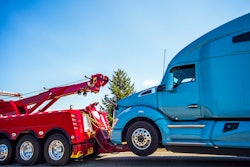The following was published in CCJ's Equipment Maintenance Toolkit, 8th edition, sponsored by Valvoline Heavy Duty. CCJ's Equipment Maintenance Toolkit is a complementary industry resource, courtesy of our partnership with Valvoline Heavy Duty. You can download the entire Toolkit here.
A properly functioning wheel-end hub is essential to all medium- and heavy-duty truck and trailer brake systems. Which means when a hub begins to leak, the outcome if untreated can quickly become catastrophic.
As such, industry manufacturers advise hubs be checked regularly as part of any preventive maintenance procedure.
Hendrickson says hub assemblies are filled with lubricant during production. On the inboard side, lubricant is contained in the hub by the hub seal. Hendrickson states this is where leaks will most commonly occur.
"Major leaks can be obvious, as it will cause lubricant to coat brake surfaces and the inside of the wheel assemblies," Hendrickson states.
But oil seals are not the only root causes of leaks, SKF adds. "If you look, you will find that leaking wheel ends leave clues pointing to which component or components are the culprits," the company states, adding sometimes a tech "may find that just changing the seal may not be your permanent solution."










